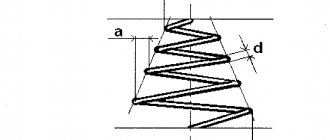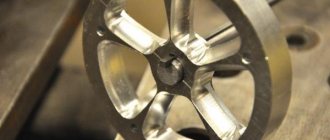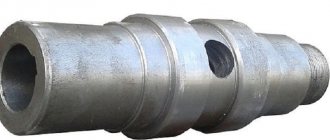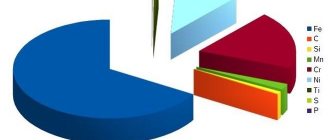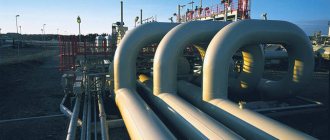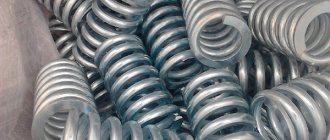Types of forgings
There are many forms of finished products. They depend on the shape of the pressing equipment used. Forgings from square billets are most often used. They are produced by stamping or machine forging.
Let's consider the existing types of forgings:
- Stainless. Made from corrosion-resistant steel. The production uses material with a homogeneous structure. The products are in demand in shipbuilding and the energy industry. Large parts such as shafts or turbines of thermal power plants are made from them, so their weight can be calculated in tons.
- Alloyed. They are made from special grades of steel that contain elements designed to improve the performance characteristics of the metal. These include chromium, manganese, nickel, silicon and cobalt. These materials can give the metal increased hardness, strength and other useful properties.
- Press forgings. Such blanks are produced by hot or cold plastic deformation of metal on presses. They are widely in demand in mechanical engineering, shipbuilding, mining and other industries.
- Hammer forgings. Obtained by metal forging. The blanks are characterized by high hardness and flexibility. They are used in the automotive industry in the manufacture of load-bearing elements and large transport components.
- Instrumental. Made from carbon or alloy steel. Excellent performance properties are in demand in the production of high-strength, high-precision tools and other industries. Differ in a variety of shapes.
- Carbonaceous. Such blanks are produced from high-strength steel grades. They are actively used in construction in the manufacture of load-bearing structures of objects. In addition, they are used in bearing production.
Forging and rolled metal should not be confused. Despite the visual similarity, the materials differ in the production method and, as a result, in the technical characteristics, even when using the same grade of steel.
Workpieces with a galvanized surface deserve special mention. The thickness of the protective layer depends on the brand of the product. Zinc is resistant to corrosion and aggressive environments. This allows you to increase the service life several times. Galvanized workpieces are in demand in difficult climatic conditions.
Despite the variety of shapes, the most popular in industry is square forging.
Preparation method
Forging comes in a variety of shapes, depending on the shape of the press. Forgings from square blanks are most often used.
They are produced in two ways:
- by cold or hot stamping. The main instrument of this production is the press;
- using machine forging, this type of metal processing differs little from hand forging. The production technology is the same, the only difference is that not human force is used, but machine power.
Using a press, you can produce forgings at a lower cost, since productivity increases due to the processing of all surfaces of the product at once. This method also allows you to achieve precision in the manufacture of forgings.
During the forging process, the parts are more durable, since the metal is in a free position at the time of processing. As a result, it becomes very strong, but at the same time such forging is characterized by high ductility.
Receipt methods
Manufacturing forgings is a rather complex technological process. There are two methods for obtaining blanks:
- Forging. This method of producing forgings is characterized by preheating the metal to a plastic state. After this, the workpiece is given the desired shape using the impact load of a hammer or press. A feature of the process is the free position of the workpiece during processing. Forgings produced by forging are distinguished by high machining allowances. This figure is almost 2 times higher than that for stamped products. Bending, drawing and drawing are also types of forging.
- Stamping. The main role in the production process is played by special equipment called a die. The matrix exerts high pressure on the workpiece. Its shape completely follows the contours of the finished product. The function of the power element is performed by the punch. The production process can take place in both cold and hot modes. The method is highly productive. No highly qualified workers are needed to service the equipment. Compared to forging, the finished product has more accurate dimensions and less surface roughness. The only disadvantage of stamping is the high cost of the equipment. It is advisable to use it only in mass production.
TEST METHODS
2.1. The batches are completed by the manufacturer from forgings manufactured according to one drawing. The conditions for completing the batch are given in table. 1.
It is allowed to combine into batches forgings made from the same grade of steel according to different drawings, similar in configuration and size.
(Changed edition, Amendment No. 1).
2.2. Each forging must be subjected to external inspection without the use of magnifying devices, unless the terms of the order provide for another inspection method.
2.3. For each group of forgings, with the exception of group I, the volume of mandatory tests specified in table is established. 4.
Table 4
| Group of forgings | Types of tests | Number of forgings per batch to be tested | |
| I | No tests | – | |
| II | Hardness Determination | 5% of the lot, but not less than 5 pcs. | |
| III | Hardness Determination | 100% | |
| IV | 1. Tensile test 2. Determination of impact strength | Up to 100 pcs. – 2 pcs., St. 100 pieces. – 1%, but not less than 2 pcs. (forgings with lower and upper hardness limits) | |
| 3. Determination of hardness | 100% | ||
| V | 1. Tensile test 2. Determination of impact strength 3. Determination of hardness | 100% | |
Notes:
1. The number of group II forgings to be tested can be increased by agreement with the consumer.
2. For forgings of group IV, it is allowed to determine the mechanical properties of forgings not with lower and upper limits of hardness, but with hardness standards that are within specified strength categories. In this case, hardness is an additional acceptance characteristic.
3. For forgings of group IV, it is allowed to determine the mechanical properties on one forging with the number of forgings in a batch of up to 20 pieces, if the difference in the hardness prints of the entire batch does not exceed 0.30 mm for KP 18 - KP45 and 0.20 mm for KP 50 – KP 80.
4. The scope of inspection of forgings supplied after preliminary heat treatment is indicated in the forging drawing.
(Changed edition, Amendment No. 1, 2, 3).
2.4. Sampling to determine the chemical composition of the metal of forgings is carried out in accordance with GOST 7565-81.
2.5. Chemical analysis of forging metal is carried out according to GOST 22536.0-87, GOST 22536.1-77, GOST 22536.2-87, GOST 22536.3-77, GOST 22536.4-77, GOST 22536.5-87, GOST 22536.6-77, GOST 22536.7-77, G OST 22536.8-87 GOST 22536.9-77, GOST 22536.10-77, GOST 22536.11-87, GOST 22536.12-77, GOST 22536.13-77, GOST 12344-78, GOST 12345-80, GOST 12346-78, GOST 12347-77, GOST 12348-78, GOST 12349-83, GOST 12350-78, GOST 12351-81, GOST 12352-81, GOST 12353-78, GOST 12354-81, GOST 12355-78, GOST 12356-81, GOST 12357-84, GOST 12358-82, GOST 12359-81, GOST 12360-82, GOST 12361-82, GOST 12362-79, GOST 12363-79, GOST 12364-84, GOST 12365-84, GOST 18895-81.
When making forgings from metal smelted by the manufacturer, the chemical composition of the steel is determined by heat analysis of a ladle sample.
When producing forgings from rolled products and ingots, the steel grade and chemical composition are established by a document on the quality of the metal manufacturer.
(Changed edition, Amendment No. 2).
2.6. The mechanical properties of forgings are determined on longitudinal, transverse, tangential or radial samples. The type of sample, if it is not indicated in the part drawing, is established by the manufacturer.
(Changed edition, Amendment No. 2).
2.7. Samples for determining the mechanical properties of forgings of group V are cut from the laps left on each forging, and group IV - from the lap on the samples or from the body of the forging, for which an additional number of forgings are made.
It is allowed to cut samples for mechanical testing of group IV forgings from a sample of the same or larger cross-section, separately forged from metal of the same heat and according to a regime similar to that for forgings.
In this case, the sample must undergo all heating, including forging or stamping, and also, simultaneously with the forgings of a given batch, heat treatment.
(Changed edition, Amendment No. 3).
2.8. The shape, dimensions and location of the test tap are determined by the drawing of the forging.
The size of the sample overlap must be sufficient to produce all required samples.
When producing one forging from an ingot, the sample overlap should be from the profitable part.
On forgings such as shafts and shells with a length of over 3 m, with appropriate indication on the forging drawing, an inlet to the samples must be provided at both ends.
2.9. Sample tappings from forgings made of alloy steel must be separated using a cold method, and from forgings made of carbon and low-alloy steel - at the discretion of the manufacturer.
2.10. Samples for mechanical testing are not allowed to be subjected to additional heat treatment or any heating.
2.11. When manufacturing several parts from one forging, one sample is taken, based on the test results of which all parts manufactured from this forging are accepted.
2.12. Samples for mechanical testing of cylindrical and prismatic forgings are cut from the lap or from the body of the forging so that their axis is at a distance of 1/3 radius or 1/6 diagonal from the outer surface of the forging.
(Changed edition, Amendment No. 3).
2.13. When cutting samples from hollow or drilled forgings with a wall thickness of up to 100 mm, the samples are cut so that their axis is at a distance of 1/2 of the forging wall thickness, and for thicknesses over 100 mm - at a distance of 1/3 of the forging wall thickness from the outer surface .
When making transverse or tangential samples, their axis must be at the same distance as for longitudinal samples.
(Changed edition, Amendment No. 1, 3).
2.14. The place for cutting samples from non-cylindrical and non-prismatic forgings in the absence of corresponding instructions on the part drawing is established by the manufacturer.
2.15. Sample blanks can be taken from forgings (not laps) by cutting with a core drill or by cutting out the forgings by machining them.
2.16. The number of samples for mechanical testing from each sample should be: one for tensile testing, two for impact strength.
2.17. The production of samples and tensile testing are carried out in accordance with GOST 1497-84 on samples of five times the length with a diameter of the calculated part of 10 mm.
It is allowed to use samples of five times the length with a diameter of the calculated part of 6 or 5 mm.
2.18. Sample production and impact strength testing are carried out in accordance with GOST 9454-78 on type 1 samples.
2.19. Brinell hardness is determined according to GOST 9012-59. If it is impossible to carry out testing on a Brinell device, it is allowed to determine hardness using other devices that provide an accuracy of ± 10% of the HB hardness number.
(Changed edition, Amendment No. 3).
2.20. If unsatisfactory results of mechanical tests are obtained for at least one of the indicators, repeated tests are carried out on a double number of samples taken from the same batch of forgings.
If, after repeated testing, positive indicators are obtained, the entire batch of forgings is considered acceptable.
If, after repeated testing, at least one of the samples gives unsatisfactory performance, the batch of forgings may be subjected to repeated heat treatment.
2.21. The number of repeated heat treatments should not be more than two.
Additional tempering is not considered heat treatment and the number of temperings is not limited. After each heat treatment or additional tempering, a batch of forgings is tested as if presented again.
The third heat treatment in the form of improvement is allowed on large forgings in cases where normalization with tempering does not provide the required mechanical properties.
2.20, 2.21. (Changed edition, Amendment No. 1).
2.22. (Deleted, Amendment No. 1).
2.23. For control testing by the consumer of the quality of workpieces and their compliance with the requirements of this standard, the sampling rules and test methods specified above must be applied.
Forging manufacturing process
Regardless of the method of obtaining the finished product, the production of forgings consists of the following stages:
- Cutting rolled metal into pieces of the required size. The standard size and cross-section of the feedstock depends on the capabilities of the suppliers. It can be a circle, square, polyhedron, and even a channel or I-beam.
- Metal deformation. During forging, the workpiece is ground under the action of repeated blows. Stamping is characterized by uniform pressure on the forging, resulting in the formation of a finished surface.
- Normalization and tempering of the workpiece.
- The quality of the finished product is determined by technical control specialists.
Application benefits
The production of the products in question is carried out by foundries. They are supplied with forging blanks, where they undergo a full technological cycle, including heat treatment. The finished product has the following advantages:
- excellent performance characteristics;
- stable mechanical properties;
- high Brinell resistance;
- low cost.
The workpiece does not require special storage conditions. If necessary, they can even be stored on an open construction site. They retain their properties for a long time.
The surface of the product is of high quality. There are no cavities, burrs, sagging or other defects on the workpieces. In addition, during metal processing there is no decarbonization of the material.
Application area
Forgings are quite widespread. This can be explained by the versatility of the form. They can be made of steel with different characteristics, depending on this forgings are used:
- to produce products with high strength, forgings made from carbon steel are used;
- forgings are used where increased ductility of the workpiece is required; they have found their application in mechanical engineering; stamping forgings are also often used in this industry;
- shipbuilding, as well as the electrical industry, use square forgings made from stainless steel;
- forgings, in the production process of which alloy steel was used, are of increased quality, and especially durable parts are made from them.
The use of parts for mechanical engineering and other industries in the manufacturing process allows several times to reduce the costs of production and processing of the product.
Moreover, the higher the dimensional accuracy of the forged workpiece, the easier it is to produce the final product from it. Tweet
GOST 7509-89
This interstate standard determines the amount of tolerances, allowances and forging allowances for steel forgings manufactured by hot die forging. There are restrictions on weight and size. The standard states that for workpieces weighing more than 250 kg and dimensions more than 2500 mm, permissible deviations, radii of rounding of external corners and other parameters are established through negotiations between the manufacturer and the customer.
Forgings are a product in demand in various industries. They are obtained by forging and stamping the workpiece. Do you think casting parts can compete in quality with forgings? Write your opinion in the comments block.
Forgings. Definition, standards, types
Forging, forged blank is an intermediate product of metallurgy, obtained as a result of plastic deformation of metal: forging, or hot stamping in forging and stamping production.
Production, taking into account the weight of products, their shapes, allowances, and quality of processing, is carried out in accordance with the following standards:
- GOST 1133-76 for round and square forgings
- GOST 8479-70 for forgings made of structural carbon and alloy steel
- GOST 7505-89 for steel stampings
- GOST 26645-85 for castings
If the dimensions of the required part significantly exceed the standards for long products, it is advisable to obtain the initial workpiece using the forging or stamping method. For example, huge shafts and rings, the mass of which can reach about 10-350 tons. Such critical parts must meet a number of technical characteristics and requirements.
According to GOST 8479-70, depending on the type of testing, forgings are divided into groups:
| Group of forgings | Types of tests | Batch completeness conditions | Delivery characteristics |
| I | No tests | Forgings of the same or different steel grades | — |
| II | Hardness Determination | Forgings of the same steel grade, subjected to heat treatment together | Hardness |
| III | Hardness Determination | Forgings of the same steel grade, subjected to heat treatment according to the same regime | Hardness |
| IV | — Tensile test, — Determination of hardness and toughness | Forgings of the same steel heat, subjected to heat treatment together | Yield strength Relative narrowing Impact strength |
| V | — Tensile test, — Determination of hardness and toughness | Each forging is accepted individually | Yield strength Relative narrowing Impact strength |
Separately, it is worth noting forgings with the Sea and River register, which are manufactured with preliminary mechanical processing and subsequent ultrasonic testing. They are used for the production of propeller shafts, pistons, lifting and mast devices, coamings and other parts used in shipbuilding.
Types and shape of forgings
According to the cross-sectional shape, forgings are:
- round (forged circle, forged axles and shafts..)
- square
- rectangular
- rings, discs (with and without holes, rolled out)
- cylinders (with and without hole)
Advantages of forgings over cast billets:
- Forgings have better mechanical properties: higher strength and toughness, and are more resistant to fatigue loads. Therefore, forgings are better suited for parts that require high strength, toughness and resistance.
- Forged blanks are less susceptible to wear and can withstand high loads well
- Forgings are better machined.
